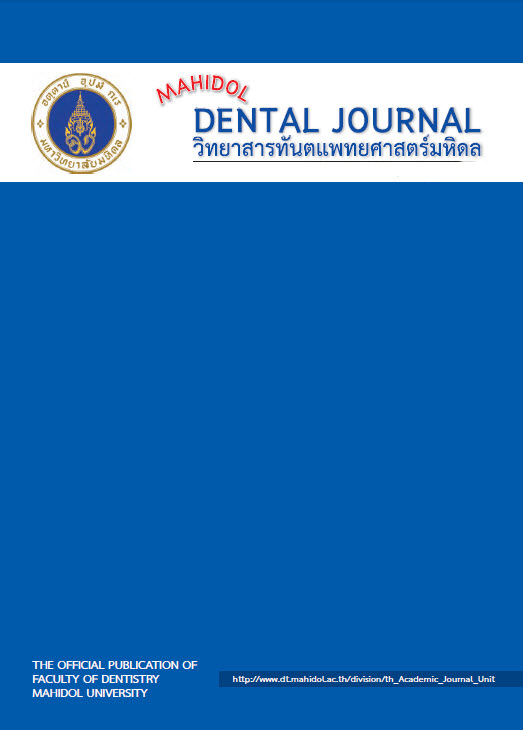Feasibility of plaque disclosing gel identification for high caries-risk in Thai schoolchildren
Main Article Content
Abstract
Objective: To evaluate the usefulness of plaque disclosing gel for predicting caries risk in schoolchildren.
Material and methods: Clinical examination of children was conducted to assess dental caries experience and stimulated salivary was collected to assess salivary flow rate and buffer capacity. Plaque disclosing gel was applied onto the tooth surfaces to identify the plaque type by observing the gel color. Information on dietary and oral hygiene habits was obtained via questionnaire-guided interviews. The data were analyzed by descriptive statistics, Chi-square test and multiple logistic regression analysis.
Results: A total of 125 9- to 16-year-olds form 6 schools in Bangkok were recruited into the study. Caries prevalence for the whole group was 60.0%. Children with caries had a significantly lower salivary flow rate and higher levels of strong acid producing plaque compared with caries-free children. Caries risk was increased in the presence of strong acid producing plaque with a sensitivity/specificity of 78.4%/44%. The Hosmer-Lemeshow goodness-of-fit test indicated that the model was also well calibrated (p= 0.915); the area under the receiver operating characteristic (ROC) curve was 0.677.
Conclusions: The determination of plaque type is useful for identifying caries risk in schoolchildren. Using plaque disclosing gel might be practical and useful for screening high caries-risk schoolchildren.
Article Details
References
Marsh P, Nyvad B. Dental Caries. The disease and its clinical management. Copenhagen: Blackwell Munksgaard; 2003.
Pisarnturakit PP, Detsomboonrat P. Microbial and Behavioral Determinants of Dental Caries in Permanent Dentition among Thai Schoolchildren. Southeast Asian J Trop Med Public Health 2017; 48: 912-25.
Chetrus V, Ion IR. Dental plaque-classification, formation, and identification. International Journal of Medical Dentistry 2013; 17: 139-43.
Marsh PD. Are dental diseases examples of ecological catastrophes? Microbiology 2003; 149: 279-94.
Piwat S, Hassan H, Kjeang T, Lindehag J, Wedin H, et al. Site-specific dental plaque pH in 13-year-old Thai
schoolchildren. Clin Oral Investig 2015; 19: 2179-86.
GC corporation GC Tri Plaque ID Gel™ a new perspective on biofilms to improve oral hygiene and
motivation. 2011. "http://www.gcamerica.com/products/preventive/GC_Tri_Plaque_ID/index.php". Accessed
July 2017.
Datta D, Kumar R, Narayanan A, Selvamary L, Sujatha A. Disclosing solutions used in dentistry.
World J Pharm Res 2017; 6: 1648-56.
GC Europe Tri plaque ID Gel. 2016. "https://www.gceurope.com/products/triplaqueidgel/". Accessed
Jun 02 2016.
Hair JF, Black WC, Babin BJ, Anderson RE, Tatham RL. Multivariate Data Analysis. sixth edition ed. Upper
Saddle River, New Jersey, United States of America: Pearson Education, Inc.; 2006.
Tayanin GL Simplified Oral hygiene index (Greene and Vermilion, 1964). " https://www.mah.se/CAPP/
Methods-and-Indices/Oral-Hygiene-Indices/Simplified-Oral-Hygiene-Index--OHI-S/". Accessed
Mar 20 2017.
Bureau of Dental Health, Department of Health, Ministry of Public Health. Report of the Eighth National
Oral Health Survey 2017. Bangkok: Samcharoen Panich (Bangkok) Co.Ltd; 2018.
Lukacs JR. Sex differences in dental caries experience: clinical evidence, complex etiology.
Clin Oral Investig 2011; 15: 649-56.
Doyal L, Naidoo S. Why dentists should take a greater interest in sex and gender. Br Dent J 2010; 209: 335-7.
M Dent J 2019 December; 39 (3): 173-180 Palinee Detsomboonrat, et al
Ferraro M, Vieira AR. Explaining gender differences in caries: a multifactorial approach to a multifactorial
disease. Int J Dent 2010; 2010: 649643.
Sgan-Cohen HD, Bajali M, Eskander L, Steinberg D, Zini A. Dental Caries Status, Socio-Economic, Behavioral and Biological Variables among 12-YearOld Palestinian School Children. J Clin Pediatr Dent 2015; 39: 331-5.
Pearce EI, Dong YM, Yue L, Gao XJ, Purdie GL, et al. Plaque minerals in the prediction of caries activity.
Community Dent Oral Epidemiol 2002; 30: 61-9.
Walsh LJ. Dental plaque fermentation and its role in caries risk assessment. Paper presented at: International
Dentistry SA (Australasian Edition), 2006.
Hoceini A, Khelil NK, Ben-Yelles I, Mesli A, Ziouani S, et al. Caries-related factors and bacterial composition
of supragingival plaques in cariesfree and caries active Algerian adults. Asian Pac J Trop Biomed
; 6: 720-26.
Prabhakar A, Dodawad R, Os R. Evaluation of Flow Rate, pH, Buffering Capacity, Calcium, Total Protein
and Total Antioxidant Levels of Saliva in Caries Free and Caries Active Children-An In Vivo Study. Int J Clin
Pediatr Dent 2009; 2: 9-12.
Preethi BP, Reshma D, Anand P. Evaluation of Flow Rate, pH, Buffering Capacity, Calcium, Total Proteins
and Total Antioxidant Capacity Levels of Saliva in Caries Free and Caries Active Children: An In Vivo
Study. Indian J Clin Biochem 2010; 25: 425-8.
Sakeenabi B, Hiremath SS. Dental caries experience and salivary Streptococcus mutans, lactobacilli
scores, salivary flow rate, and salivary buffering capacity among 6-year-old Indian school children.
J Int Soc Prev Community Dent 2011; 1: 45-51.
Animireddy D, Reddy Bekkem VT, Vallala P, Kotha SB, Ankireddy S, et al. Evaluation of pH, buffering
capacity, viscosity and flow rate levels of saliva in caries-free, minimal caries and nursing caries
children: An in vivo study. Contemp Clin Dent 2014; 5: 324-8.
Koch G. Importance of early determination of caries risk. Int Dent J 1988;38(4):203-10.
Johnson NW. Concluding perspectives and future directions. Cambridge, New York: Cambridge
University; 1991.
Stamm JW, Disney JA, Beck JD. The University of North Carolina caries risk assessment study: Final
results and some alternative modelling approaches. Rochester: University of Rochester; 1993.
Klock B, Krasse B. Effect of caries-preventive measures in children with high numbers of S. mutans
and lactobacilli. Scand J Dent Res 1978; 86: 221-30.
Russell JI, MacFarlane TW, Aitchison TC, Stephen KW, Burchell CK. Prediction of caries increment in
Scottish adolescents. Community Dent Oral Epidemiol 1991; 19: 74-7.
Jayanthi M, Shilpapriya M, Reddy VN, Elangovan A, Sakthivel R, et al. Efficacy of three-tone disclosing
agent as an adjunct in caries risk assessment. Contemp Clin Dent 2015; 6: 358-63.
Nagashima Y, Shigeishi H, Fukada E, Amano H, Urade M, et al. Self-check with plaque disclosing
solution improves oral hygiene in schoolchildren living in a children's home. Arch Public Health 2018;
: 50.


